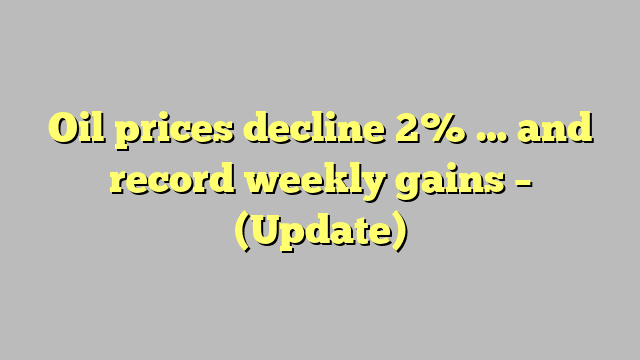Oil prices fell by about 2%, at the end of trading today, Friday, July 14 (2023), for the first time in 4 sessions, but it achieved its third weekly gain for the first time since April.
The oil markets suffer from volatile transactions. The morning trading started on the upside, amid fears of a supply shortage due to supply disruptions in Libya and Nigeria.
And faced hopes of higher demand for oil under pressure amid fears of upcoming increases in interest rates by the Federal Reserve may push the price of the dollar to rise and increase fears of economic recession.
The weekly report of Baker Hughes showed that the number of oil drilling rigs in the United States decreased by 3 during the past week, bringing the total to 537 rigs.
Oil prices today
At the end of the session, benchmark Brent crude futures – for September 2023 delivery – fell by 1.8%, to $79.87 a barrel.
US West Texas Intermediate crude futures – August 2023 delivery – fell 1.9% to $75.42 a barrel, according to figures seen by the specialized energy platform.
And oil prices ended their dealings, yesterday, Thursday, July 13, 2023, with an increase of about 1.5%, to continue to reap gains for the third day in a row, amid hopes for a recovery in demand.
Both benchmarks (Brent and West Texas Intermediate) achieved gains of about 1.8% and 2.1%, respectively, during the week ending today.
oil supplies
Yesterday, Thursday, a number of oil fields in Libya were closed in local protests against the kidnapping of the former Minister of Finance in the Government of National Accord, Faraj Boumtari, after news of his candidacy for the position of central governor.
The leader of the Zawiya tribe said that production in El Feel, El Sharara and the 108 oil field in Libya had stopped; Protesting the kidnapping of the former Finance Minister, Reuters reported.
The protesters issued a video statement from the 108 oil field, saying, as they closed one of the valves: “We confirm the continuation of the oil blockade, and we may escalate the situation to more than that if Faraj is not released.”
On the other hand, two engineers working in the Sharara field (one of the largest production areas in Libya with a capacity of 300,000 barrels per day) confirmed that the protesters had not yet entered the oil field.

Separately, Shell has halted shipments of Nigerian crude oil due to a potential leak at a terminal, according to data seen by the specialist energy platform.
ANZ Research said that the protests in Libya alone could stop the flow of more than 250,000 barrels of oil per day.
“Crude oil prices are getting support from expectations that the oil market will become very tight as Libya and Nigeria deal with the turmoil, while Russian crude exports are finally falling,” said OANDA analyst Edward Moya, according to Reuters.
Saudi Arabia and Russia, the world’s largest oil exporters, agreed this month to deepen oil cuts that have been in place since November last year; This provides further support for crude oil prices.
demand for oil
On Thursday, the Organization of the Petroleum Exporting Countries (OPEC) raised its forecast for oil demand for 2023, adding that it expects demand to grow by 2.2% in 2024.
The National Bank of Australia said, in a research note, today, Friday, that it expects OPEC’s expectations, if realized, to “deliver oil prices well above $100 a barrel,” adding that the depreciation of the US dollar continues to boost commodity prices.
US consumer prices rose modestly in June, at the lowest annual rate of increase in more than two years; As inflation continued to decline.
Producer prices also rose slightly in June, the annual increase being the smallest in nearly 3 years.
Both indicators gave hope to the markets that the US Federal Reserve may be closer to ending its fastest tightening campaign since the 1980s.

Leave a Reply